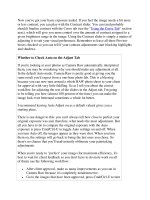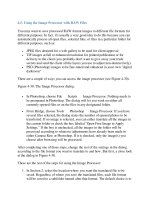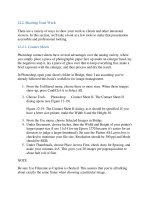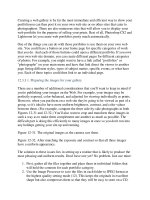Professional Information Technology-Programming Book part 60 pps
Bạn đang xem bản rút gọn của tài liệu. Xem và tải ngay bản đầy đủ của tài liệu tại đây (39.86 KB, 9 trang )
We Want to Hear from You!
As the reader of this book, you are our most important critic and commentator. We
value your opinion and want to know what we're doing right, what we could do
better, what areas you'd like to see us publish in, and any other words of wisdom
you're willing to pass our way.
You can email or write me directly to let me know what you did or didn't like
about this bookas well as what we can do to make our books stronger.
Please note that I cannot help you with technical problems related to the topic of
this book, and that due to the high volume of mail I receive, I might not be able to
reply to every message.
When you write, please be sure to include this book's title and author as well as
your name and phone or email address. I will carefully review your comments and
share them with the author and editors who worked on the book.
Email:
Mail: Mark Taber
Associate Publisher
Sams Publishing
800 East 96th Street
Indianapolis, IN 46240 USA
Introduction: Welcome to PHP
This book is about PHP, one of the most popular web scripting languages around.
It is a book for busy people. Each lesson takes just 10 minutes to work through, so
if you have wanted to learn PHP for a while but have never really had the chance,
don't put it off any longer!
Who This Book Is For
This book is aimed at those who want to learn PHP, even if they don't have any
previous programming or scripting experience.
You can even use this book to learn
PHP as a first programming language if you do not have any previous experience.
If you have some previous programming experience but have not written for the
web before, you can use this book to learn about the PHP language and how to
apply programming techniques to the web environment.
This book does not teach you HTML. Although knowledge of HTML is not a
prerequisite, having published web pages in the past will be an advantageeven if
you do not usually hand-code HTML.
How This Book Is Organized
This book is organized into five parts.
Part I: PHP Foundations
The lessons in Part I introduce the basic building blocks of the PHP language:
Lesson 1: Getting to Know PHP. This chapter intro
duces you to what PHP is
all about and gives some simple examples to show how PHP is used inside a
web page.
Lesson 2: Variables. This chapter explains how you assign values to
variables and demonstrates some simple expressions.
Lesson 3: Flow Control. This chapter examines the conditional and looping
constructs that allow you to control the flow of a PHP script.
Lesson 4: Functions. This chapter explains how you can modularize and
reuse a frequently used section of code as a function.
Part II: Working with Data
The lessons in Part II examine in more detail the different types of data that can be
manipulated by PHP:
Lesson 5: Working with Numbers. This chapter gives more detailed
examples of the numeric manipulation you can perform in PHP.
Lesson 6: Working with Strings. This chapter examines the powerful set of
string functions that PHP provides.
Lesson 7: Working with Arrays. This chapter explains how arrays work and
examines the PHP functions that can manipulate this powerful data type.
Lesson 8: Regular Expressions.
This chapter shows how to perform complex
string manipulation by using powerful regular expressions.
Lesson 9: Working with Dates and Times.
This chapter examines how to use
date and time values in a PHP script.
Lesson 10: Using Classes. This chapter introduces you to object-oriented
PHP and examines how you define and access a class in a script.
Part III: The Web Environment
The lessons in Part III deal with using PHP specifically in the web environment:
Lesson 11: Processing HTML Forms. This chapter shows how you use PHP
to process user-submitted input from an HTML form.
Lesson 12: Generating Dynamic HTML. This chapter examines some
techniques for creating HTML components on-the-fly from PHP.
Lesson 13: Form Validation. This chapter examines some techniques for
validating user-submitted input from an HTML form.
Lesson 14: Cookies and Sessions. This chapter shows how to pass data
between pages by using PHP sessions and how to send cookies to a user's
browser.
Lesson 15: User Authentication. This chapter examines some techniques for
validating user-submitted input from an HTML form.
Lesson 16: Communicating with the Web Server.
This chapter looks at ways
in which PHP can interact with a web server.
Part IV: Using Other Services from PHP
Part IV looks at how PHP can communicate with external programs and services:
Lesson 17: Filesystem Access.
This chapter examines the PHP functions that
enable you to access the filesystem.
Lesson 18: Host Program Execution. This chapter examines the PHP
functions that enable you to execute programs on the host system.
Lesson 19: Using a MySQL Database. This chapter shows how to use a
MySQL database for data storage and retrieval from PHP.
Lesson 20: Database Abstraction. This chapter explains how you can access
a database through an abstraction layer to make scripts more portable.
Lesson 21: Running PHP on the Command Line. This chapter shows how
you can use PHP as a powerful shell scripting language.
Lesson 22: Error Handling and Debugging. This chapter discusses some
techniques for finding and fixing bugs in scripts.
Part V: Configuring and Extending PHP
The final part of the book deals with PHP administration:
Lesson 23: PHP Configuration. This chapter explains some of the popular
configuration options that can be set at runtime to change the behavior of
PHP.
Lesson 24: PHP Security. This chapter discusses security issues in PHP
scripts and shows how you can use Safe Mode on a shared web server.
Lesson 25: Using PEAR.
This chapter introduces the freely available classes
that are available in the PHP Extension and Application Repository.
Versions of Software Covered
At the time of writing, the current version of PHP is PHP 5.0.3. Unless otherwise
stated, all code examples in this book will work with PHP 4.1.0 and higher.
Conventions Used in This Book
This book uses different typefaces to differentiate between code and regular
English, and also to help you identify important concepts.
Text that you type and text that should appear on your screen is presented in
monospace type.
It will look like this to mimic the way text looks on your screen.
Placeholders for variables and expressions appear in monospace italic font.
You should replace the placeholder with the specific value it represents.
A Note presents interesting pieces of information related to the
surrounding discussion.
A Tip offers advice or teaches an easier way to do something.
A Caution advises you about potential problems and helps you
steer clear of disaster.
Lesson 1. Getting to Know PHP
In this lesson you will find out what PHP is all about and see what it is able to do.
PHP Basics
There is a good chance you already know a bit about what PHP can dothat is
probably why you have picked up this book. PHP is hugely popular, and rightly
so.
Even if you haven't come across an existing user singing its praises, you've almost
certainly used a website that runs on PHP. This lesson clarifies what PHP does,
how it works, and what it is capable of.
PHP is a programming language that was designed for creating dynamic websites.
It slots into your web server and processes instructions contained in a web page
before that page is sent through to your web browser. Certain elements of the page
can therefore be generated on-the-fly so that the page changes each time it is
loaded. For instance, you can use PHP to show the current date and time at the top
of each page in your site, as you'll see later in this lesson.
The name PHP is a recursive acronym that stands for PHP: Hypertext
Preprocessor. It began life called PHP/FI, the "FI" part standing for Forms
Interpreter. Though the name was shortened a while back, one of PHP's most
powerful features is how easy it becomes to process data submitted in HTML
forms. PHP can also talk to various database systems, giving you the ability to
generate a web page based on a SQL query.
For example, you could enter a search keyword into a form field on a web page,
query a database with this value, and produce a page of matching results. You will
have seen this kind of application many times before, at virtually any online store
as well as many websites that do not sell anything, such as search engines.
The PHP language is flexible and fairly forgiving, making it easy to learn even if
you have not done any programming in the past. If you already know another
language, you will almost certainly find similarities here. PHP looks like a cross
between C, Perl, and Java, and if you are familiar with any of these, you will find
that you can adapt your existing programming style to PHP with little effort.
Server
-Side Scripting
The most important concept to learn when starting out with PHP is where exactly it
fits into the grand scheme of things in a web environment. When you understand
this, you will understand what PHP can and cannot do.
The PHP module attaches to your web server, telling it that files with a particular
extension should be examined for PHP code. Any PHP code found in the page is
executedwith any PHP code replaced by the output it producesbefore the web page
is sent to the browser.
File Extensions The usual web server configuration is that
somefile.php will be interpreted by PHP, whereas
somefile.html will be passed straight through to the web
browser, without PHP getting involved.
The only time the PHP interpreter is called upon to do something is when a web
page is loaded. This could be when you click a link, submit a form, or just type in
the URL of a web page. When the web browser has finished downloading the
page, PHP plays no further part until your browser requests another page.
Because it is only possible to check the values entered in an HTML form when the
submit button is clicked, PHP cannot be used to perform client-side validationin
other words, to check that the value entered in one field meets certain criteria
before allowing you to proceed to the next field. Client-
side validation can be done
using JavaScript, a language that runs inside the web browser itself, and JavaScript
and PHP can be used together if that is the effect you require.
The beauty of PHP is that it does not rely on the web browser at all; your script
will run the same way whatever browser you use. When writing server-side code,
you do not need to worry about JavaScript being enabled or about compatibility
with older browsers beyond the ability to display HTML that your script generates
or is embedded in.
PHP Tags
Consider the following extract from a PHP-driven web page that displays the
current date:
Today is <?php echo date('j F Y');?>
The <?php tag tells PHP that everything that follows is program code rather than
HTML, until the closing ?> tag. In this example, the echo command tells PHP to
display the next item to screen; the following date command produces a
formatted version of the current date, containing the day, month, and year.
The Statement Terminator The semicolon character is used to
indicate the end of a PHP command. In the previous examples,
there is only one command, and the semicolon is not actually
required, but it is good practice to always include it to show that a
command is complete.
In this book PHP code appears inside tags that look like <?php ?>. Other
tag styles can be used, so you may come across other people's PHP code beginning
with tags that look like <? (the short tag), <% (the ASP tag style) or <SCRIPT
LANGUAGE="php"> (the script tag).
Of the different tag styles that can be used, only the full <?php tag and the script
tag are always available. The others are turned off or on by using a PHP
configuration setting. We will look at the php.ini configuration file in Lesson
23, "PHP Configuration."
Standard PHP Tags It is good practice to always use the <?php
tag style so your code will run on any system that has PHP
installed, with no additional configuration needed. If you are
tempted to use <? as a shortcut, know that any time you move
your code to another web server, you need to be sure it will
understand this tag style.
Anything that is not enclosed in PHP tags is passed straight through to the browser,
exactly as it appears in the script. Therefore, in the previous example, the text
Today is appears before the generated date when the page is displayed.









